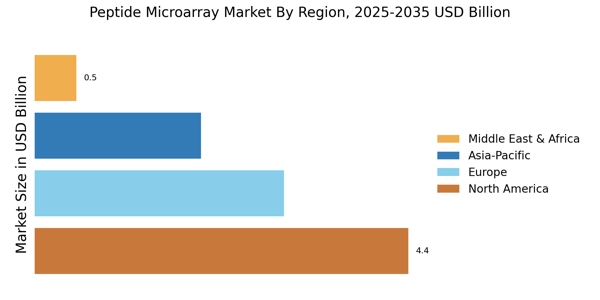Collaborative Research Initiatives
Collaborative research initiatives among academic institutions, biotechnology firms, and pharmaceutical companies are playing a pivotal role in the Peptide Microarray Market. These partnerships are fostering innovation and accelerating the development of new applications for peptide microarrays. By pooling resources and expertise, stakeholders are able to explore novel therapeutic targets and enhance the understanding of disease mechanisms. Recent collaborations have led to breakthroughs in areas such as cancer research and autoimmune disorders, highlighting the versatility of peptide microarrays. The market is likely to benefit from these initiatives, as they not only enhance research capabilities but also facilitate the translation of findings into clinical applications. This collaborative spirit is expected to drive the Peptide Microarray Market forward, with an anticipated increase in funding and research output.
Increased Investment in Biotechnology
The Peptide Microarray Market is benefiting from increased investment in biotechnology, which is fostering innovation and expanding research capabilities. Venture capital funding and government grants are being directed towards the development of advanced peptide microarray technologies. This influx of capital is enabling companies to enhance their product offerings and improve the performance of existing microarrays. Market data indicates that the biotechnology sector is expected to grow at a compound annual growth rate of approximately 8% over the next five years, which will likely translate into increased demand for peptide microarrays. As more organizations recognize the potential of peptide microarrays in various applications, including diagnostics and therapeutics, the market is poised for substantial growth. This trend underscores the importance of investment in driving the Peptide Microarray Market forward.
Growing Applications in Drug Discovery
The Peptide Microarray Market is witnessing a growing application in drug discovery processes. As pharmaceutical companies seek to streamline their drug development pipelines, peptide microarrays offer a powerful platform for screening potential drug candidates. These microarrays enable the simultaneous analysis of multiple peptides, facilitating the identification of lead compounds with desirable biological activity. Market analysis suggests that the drug discovery segment is projected to account for a significant share of the peptide microarray market, driven by the increasing need for efficient and cost-effective screening methods. Furthermore, the ability to rapidly assess peptide interactions with various targets positions peptide microarrays as invaluable tools in the early stages of drug development. This trend is likely to bolster the Peptide Microarray Market, as more companies adopt these technologies to enhance their research capabilities.
Rising Demand for Personalized Medicine
The increasing focus on personalized medicine is significantly influencing the Peptide Microarray Market. As healthcare shifts towards tailored therapies, the need for precise diagnostic tools becomes paramount. Peptide microarrays facilitate the identification of specific biomarkers, enabling the development of customized treatment plans. This trend is underscored by the growing prevalence of chronic diseases, which necessitate individualized approaches to treatment. Market data indicates that the demand for personalized medicine is expected to reach USD 2 trillion by 2030, thereby creating a robust market for peptide microarrays. The ability to analyze patient-specific responses to therapies positions peptide microarrays as essential tools in the evolving landscape of personalized healthcare, further driving the growth of the Peptide Microarray Market.
Technological Advancements in Peptide Microarray Market
The Peptide Microarray Market is experiencing a surge in technological advancements that enhance the efficiency and accuracy of peptide synthesis and analysis. Innovations such as high-throughput screening and improved detection methods are driving the market forward. For instance, the integration of artificial intelligence and machine learning in data analysis is streamlining the interpretation of complex datasets. This technological evolution is not only reducing costs but also increasing the throughput of peptide microarrays, making them more accessible for research and clinical applications. As a result, the market is projected to witness substantial growth, with estimates suggesting a compound annual growth rate of over 10% in the coming years. These advancements are likely to attract investments and foster collaborations, further propelling the Peptide Microarray Market.


















Leave a Comment